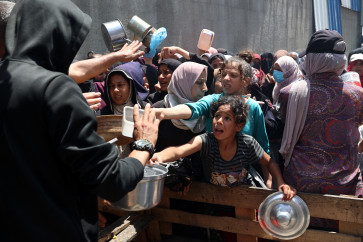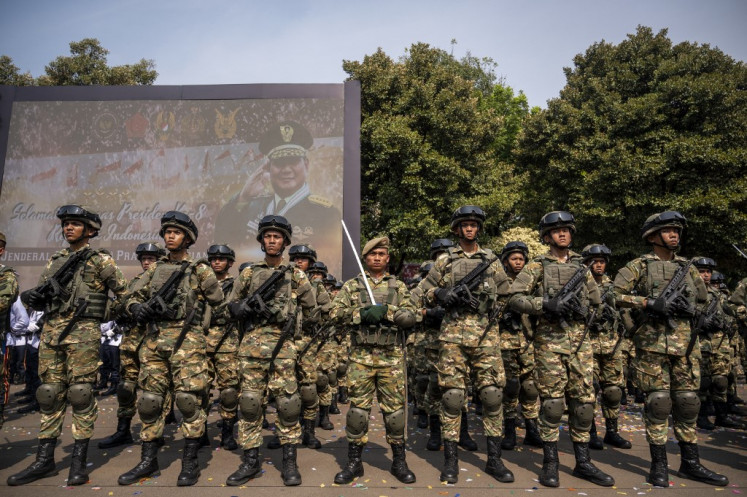Lesson learned from World Food Security Summit 2009
The Third World Food Security Summit at the Food and Agriculture Organization (FAO) headquarters in Rome last month was a failure
Change text size
Gift Premium Articles
to Anyone

T
he Third World Food Security Summit at the Food and Agriculture Organization (FAO) headquarters in Rome last month was a failure. The summit's initial function has been to ensure binding aid commitments from international communities (more specifically rich countries) for the eradication of world hunger and poverty problems.
However, as reported by international media, the three-day summit failed to deliver any commitments from any nations. Wealthy countries' leaders lack the political will to commit to solving these problems. There was no increase in financial commitments to eradicate hunger, as developed nations would not agree to allocate the hoped for US$44 billion in agricultural aid per year.
Hunger and poverty problems should be solved and addressed properly.
But the summit at least managed to encourage the leaders of developing countries to commit themselves to prioritizing agriculture and food security, rather than depending on money from the international community.
Developing countries must move forward with their own commitments, invest in political capital and political will to move their own programs forward and support agriculture. As we have been witnessing globally, the food security situation has worsened and continues to represents a serious threat to humanity. In developing countries, the number of people suffering from hunger has grown relentlessly in recent years.
The UN Population Fund (2009) estimates that by 2050 the world population will reach 9.1 billion people. Asia's population will increase from 4.1 billion to 5.2 billion with a 2.32 fertility rate. In short, by 2050 there will be 2.3 billion more people to feed and water on a planet trying to cope with substantial climate change.
Global demand for food, feed and fiber will double. While, crops may increasingly be used for bio-energy and other industrial purposes. New and traditional demands for agricultural products will put growing pressure on already scarce agricultural resources.
A healthy and productive agricultural sector will be a determinant factor in overcoming hunger and poverty globally. Developing countries need the development, economic and policy tools required to boost their agricultural production and productivity.
Investment in agriculture must be increased because for the majority of poor countries an efficient agricultural sector is essential for coping with hunger and poverty problems.
The ongoing food crisis is the result of 20 years neglect and under investment in the agriculture sector. Even though agriculture directly and indirectly provides livelihoods to over 50 percent of world's poor, the priority given to the sector is still far from enough.
The future of agriculture and food security is also closely linked to global climate change. FAO expects that developing countries may experience a decline of between nine to 21 percent in overall potential agricultural productivity as result of global warming.
Climate change will lead the higher frequency of extreme events such as drought, heat waves, flooding, severe storms and outreaks of plant diseases. Those impacts will in turn significantly threaten food production and farming productivity on a global scale.
Strategies of adaptation and mitigation on the impact of climate change should be widely disseminated to related parties. Increasing soil carbon sequestration through forestry and agro-forestry initiatives and tillage practices, improving efficiency nutrient management and restoring degraded lands are among examples of these startegies.
The other crucial problems related to agriculture production are water scarcity and post-harvest losses. Long droughts are occuring more frequently around the world, so farmers face more serious problem in coping with water problems that threaten not only crop irrigation but their own drinking water.
Several priorities in coping with farming production problems include improving the efficiency of agricultural inputs, developing and improving crop varieties, heavily investing in agricultural research and development and closing the existing yield gap.
Input efficiency can be achieved through conservative agriculture such as zero tillage and reductions in fertilizer usage by increasing the supply of biologically-fixed nitrogen. Developing and improving locally resourced crop varieties will be useful for adapting to climate change and water scarcity.
Investment in agricultural development programs supporting small-scale farmers seems the best way to increase food production locally. Improving modern technologies on farms should also improve sustainability socially and environmentally. Appropriate funding for sustainable agriculture not only produces food but also generates income and strengthens rural communities.
The writer is a lecturer at School of Agriculture Gadjah Mada University and PhD Candidate at The University of Tokyo









